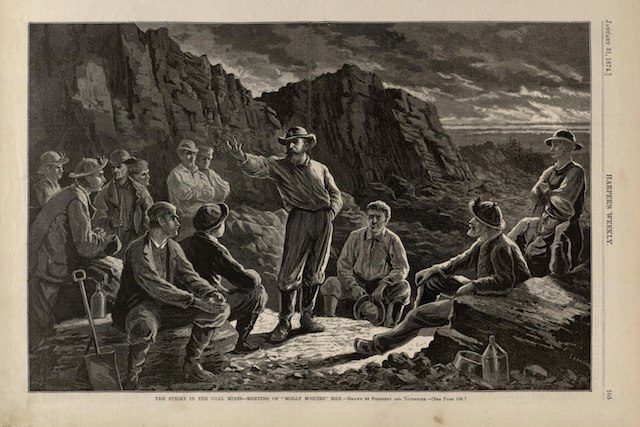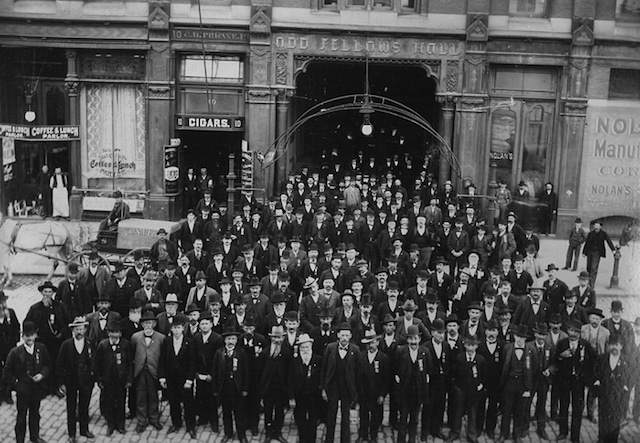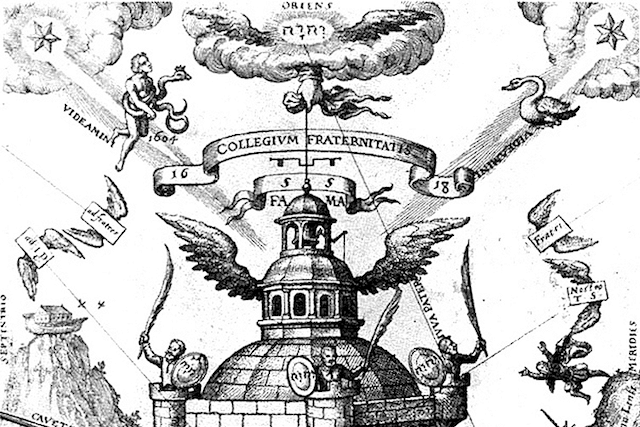Our history is full of secret societies and shadowy groups, both real and perceived. Sure, you’ve heard about the famous ones, such as the Knights Templar, Freemasons, and the Illuminati. However, there are more. So, so many more. Some of them are relatively low-key, regional affairs, while others were powerful and active groups that shaped history (or tried to do so, anyway). Today, we’ll lift the veil and look into the secrets of some of these little known secret societies.
10. The Molly Maguires

The Molly Maguires were a secret society of Irish immigrants to the Pennsylvania area. Well, the capacity at which they existed and operated is actually a matter of some historical debate, but that’s secret societies for you, right?
The Maguires were supposedly a violent faction that terrorized Schuylkill County between 1861 and 1875, when a whole bunch of arsons, murders and assorted acts of violence were pinned on them. Reportedly, they were an evolution of Irish rural societies such as the Ribbonmen and the Whiteboys. These were essentially groups of working-class folks banding together and lashing out at landlords and higher-ups treating them badly, and it looks like the Molly Maguires kept up the tradition in the New Country. The Great Potato Famine had caused a massive influx of Irish Catholics in the U.S., and the country responded with unmitigated discrimination based on both their origin and their religion. As a result, many of them ended up taking labor-intensive and dangerous jobs, such as mining. Supposedly, this, along with the fact that the miners started getting drafted in the Civil War (which they perceived as a “rich man’s war”), gave the spark for the Molly Maguires, who started committing acts of violence and assassinating mine foremen left and right.
The President of the Reading Railroad eventually had enough and sent the Pinkerton Agency to crush the Maguires, which they eventually did after a lengthy cover operation. After a controversial and loaded legal proceeding that the absurdly biased railroad President himself presided over. As a result, 20 supposed Molly Maguires were sentenced to death, with 10 of them executed on the “Black Thursday” of June 21, 1877. Even today, it remains unclear whether there ever was an organized group of “Molly Malones.” However, historians tend to agree that the way the supposed group was taken care of was a horrifying “perversion” of justice.
9. The Knights of Pythias

Founded during the Civil War by Justus H. Ratbone, the Knights of Pythias drew inspiration from the Greek tale of Damon and Pythias. The organization had a complex structure with three tiers and tons of fancy titles for its members, and the initiation ceremony involved secret rituals and the candidate received a “ceremonial sword” that bore the inscription “FCB,” symbolizing the three virtues of the society: friendship, charity and benevolence. Despite this, the group appears to have been closer to a fancy club with regular contributions to charity than the kind of villainous societies conspiracy theorists so love. You could join the Knights of Pythias if you were in good health, believed in “a supreme being,” and, of course, were a man (though there was also a subsection for women).
The secret society bears the distinction of being “the first fraternal organization to be chartered by an act of Congress,” and had nearly a million members at the absolute heights of its popularity. It can count several presidents, vice presidents, Supreme Court justices and prominent politicians amongst its historical membership, along with the legendary jazz musician Louis Armstrong. The Knights of Pythias are still operational, though in much smaller numbers than during their heyday.
8. The Carbonari

The Carbonari, or “charcoal burners,” were an Italian early-19th century secret society, with all the usual rituals, titles and other secret society trimmings, but with a very clear goal in mind: To oppose the conservatives who took control of the country after the defeat of Napoleon (whose conquest shenanigans had earned him the title of the King of Italy, among other things).
The Carbonari were patriotic liberals who were either a spin-off of the Freemasons or a “mutual-aid” group that had come from France. They were largely aristocrats and middle-class folks who were keen to hang on to their power and influence, and for a while, it really looked like they were a powerful player: In just a few years, Carbonari lodges spread like wildfire, and they started instigating rebellions and revolutions all around the country. Their mightiest and most successful effort was the Neapolitan Revolution, which was the Italian part of the Revolutions of 1820. The Neapolitan Revolution actually forced King Ferdinand I to get around to giving the country a constitution. Unfortunately for the Carbonari, Austria soon got involved and ruined their efforts, and their other attempts at revolt were unsuccessful. By the time 1931 rolled along and Giuseppe Marzini unveiled his patriotic, conservative “Young Italy” movement, the Carbonari were more or less out of ammo and on their way toward obscurity.
7. The Ancient Order of the Foresters

The Ancient Order of Foresters is a secret society that was technically founded in 1834, but their true origins lie in an older, 18th century society known as the Royal Foresters. The names might have a distinctly rural and possibly mildly ominous sound to them, but in reality, the name refers to the society’s practice of assisting “fellow men who fell into need as they walked through the forests of life.” Basically, when the breadwinner of a member’s family was unable to work due to illness or other issue, the Foresters drew from their common fund to be able to provide sick pay or, if things took a turn for the absolute worst, funeral costs for such families.
In more recent years, the society has evidently decided to rename themselves in a way that better reflects their stated purpose, and now call themselves the Foresters Friendly Society.
6. Black Hand

The early 20th century Serbian Black Hand, or Ujedinjenje Ili Smirt (which is Serbo-Croation for “union or death”), was not a very nice group of people. They were a secret society that used terrorism in order to free the Serbs outside their country from Ottoman and/or Hapsburg rule. The organization was formed in 1911, based in Belgrade and largely comprised of military operatives and a handful of government officials. After a number of propaganda campaigns and terror attacks by its various cells, they were finally taken apart in 1917 when its leaders, including founder Colonel Dragutin Dimitrevic, were executed, and over 200 Black Hand members were sent to prison.
Still, despite its relatively short existence, the Black Hand left its lasting mark in history. They were heavily involved in the successful 1914 plot to assassinate the Austrian archduke Franz Ferdinand — an act of violence that sparked a little thing called World War I.
5. The Orange Order

The Irish Protestant society known as the Orange Order was born in 1795, after long-standing tensions between Protestant and Catholic gangs culminated in the Battle of the Diamond, where the Protestant Peep o’Day Boys outnumbered their opponent. The confrontation ended with the deaths of an estimated 30 Catholic fighters, and the victors agreed to form the Orange Order as a “Protestant defense association.”
Since these violent origins, the society has shifted towards a rather more conventional organization that has parades, theme songs and “lodges” that are basically clubs. There are over 1,100 lodges, and the society’s roughly 34,000 members live in places as distant as Togo, Australia and Ghana. However, while the Orange Order says it “does not foster resentment and intolerance,” its loyalist/protestant roots have made it a popular target for the IRA and other republican dissidents, who killed over 330 of their members during the Troubles, the late 20th century conflict over North Ireland. The most recent Orange brother to perish in such an incident was David Black, a prison officer who was murdered in 2012.
4. The Ancient Order of United Workmen

The Ancient Order of United Workmen wasn’t quite as ancient as its fancy name would have you believe. Its fourteen founding members started the society on October 27, 1968 in Meadville, Pennsylvania, and it went on to become an extremely popular crew among the working class people. AOUW was essentially a “fraternal benefits society” that existed to provide affordable financial protection for its members, and in less than two decades, it had over 176,000 members all over the US.
Apart from its insurance-style operation, the Ancient Order of United Workmen was apparently a fairly straightforward secret society type of deal, with the usual trimmings of secret rituals, symbols, lodges and fraternal meetings. However, it appears that over time, the society faded away and its buildings were repurposed. In some places, the insurance part of things took over — for instance, North Dakota’s AOUW eventually morphed into the Pioneer Mutual Life Insurance Company.
3. International Order of St. Hubertus

The International Order of St. Hubertus is arguably most notable for Justice Antonin Scalia, who may or may not have been a member, but definitely was in the company of members of this secret society when he died on February 13, 2016. A knightly order that was founded by a Bavarian count in 1695, the Order is known as the “Illuminati of the hunting world.”
The secret society’s emphasis is indeed on various hunting exhibitions, but it has all the weird membership titles and super-secretiveness you’ve by now come to expect from a decent secretive brotherhood. Many of its members are high-powered businessmen and lawyers, who gather together to shoot at things and, presumably, to discuss whatever such people discuss during reloads. Of course, this is the kind of stuff conspiracy theorists love, but there’s a perfectly good chance that the International Order of St. Hubertus really is nothing more than a sort of ultra-exclusive “boys’ club” for leaders of the industry who love to shoot at animals on occasion.
2. Hermetic Order of the Golden Dawn

The Hermetic Order of the Golden Dawn were a short-lived, but arguably pretty influential secret society. They only operated from 1888 to 1901, but they were an interesting, secretive group that focused on natural magic, with the goal of providing its members with “enriched connection with a spiritual realm of being. Although they were mostly doing their own thing, writer Dennis Denisoff argues that they were very much a part of the era’s broader fascination in matters of the occult, both drawing inspiration from various secret societies and belief systems before them, and contributing to the occult culture in its turn.
The Order was founded by three British Freemasons, and grew in influence and popularity alike, peaking around the 1890s. Unfortunately, their spiritual connections weren’t enough to spare them from infighting, which ultimately disbanded this particular secret society.
1. Rosicrucians

If some of the secret societies on this list sound like glorified clubs for dudes who want to lounge around in comfy chairs and smoke cigars, Rosicrucians are very much the real deal, to the point that no one’s really sure at which capacity they exist, and what they know and do. Supposedly, they’re a “worldwide brotherhood” who claim to “possess esoteric wisdom” from ancient history, but their earlier incarnations are very difficult to ascertain — though legend has it they were heavily into occultism and alchemy, and that people like Francis Bacon were involved with the organization. There are also several mysterious (and anonymously published) books detailing old Rosicrucian customs that were reportedly written by various influential early 17th century writers. A man called Christian Rosencreutz is generally credited as the group’s founder, though he is quite likely a fictional character.
A more modern version of the Rosicrucians arose in the 19th century, when interest in the occult revived, and two of the most successful Rosicrucian societies — Rosicrucian Fellowship and The Ancient Mystical Order Roase Crucis — were established in the 20th century.